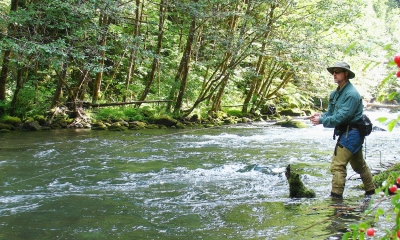
How to fish for crappie
Crappie are scrappy, hard-fighting fish, and with a two-rod validation you can double the excitement of reeling in these delicious panfish. Lucky for us, Oregon has lots of opportunity for crappie, and some of our waterbodies are considered premier crappie fishing destinations!

Species
Crappie are considered a panfish-- a non-technical term for freshwater fish popular for food and sport (usually with light tackle) and that can fit in a frying pan. Oregon has two species of crappie, black and white. Both are schooling fish, meaning they like to stay in loose groups. Though we don’t know why fish hang out in schools, if could be to avoid predators, increase foraging success, or to swim more efficiently.
Black crappie
Black crappie are silvery with numerous black or dark green blotches and no distinct vertical bars. This makes them appear darker than white crappie. Black crappie have a rounder body shape than white crappie with a smaller, more upturned mouth. Additionally, the dorsal fins of black crappiehave seven or eight spines. Black crappie tend to prefer cool, clear water with vegetation and their diet heavily relies on insects and crayfish.
White crappie
White crappie are often confused with black crappie. White crappie have silvery bodies with blackish green mottling forming narrow vertical bars on the sides. The body shape is more elongate than black crappie and their mouths are larger and not as upturned. Their dorsal fins have five or six spines. White crappie are more tolerant of murkier water with less vegetation than black crappie and their diet mostly consists of minnows.
License requirements
An Oregon fishing license is all that’s required to fish for crappie. Youth 12-17 years old need a youth fishing license and kids under 12 fish for free. If you plan on fishing with two rods you will need to purchase a two-rod validation.
Where and when to fish
You can find crappie in ponds, lakes, reservoirs, and large, slow moving rivers across Oregon. The key words are still or slow-moving waters. Crappie fishing is best during the cool weather of early spring and fall when they move into the shallow ends of coves. At these times, crappie congregate in loose schools around sunken logs or brushy cover or just beyond the weeds in water 6 to 15 feet deep.
If you’re out when the sun is on the water, look for areas around sunken logs or stick close to boat or fishing docks. In the mornings and evenings of spring and fall, when the sun is off the water, crappie will likely be in weedy vegetation feeding at the surface of the water.
During the winter and summer, crappie often move to deeper water along vertical structure such as pilings or dams. If you’re targeting crappie during these seasons: fish deep, use different baits and colors to entice the fish, and troll the water.
Four of the best places in Oregon to go crappie fishing are: Brownlee Reservoir, Prineville Reservoir, Henry Hagg Lake and the Freeway Ponds.
Fishing techniques
The hardest part of crappie fishing is finding schools of fish. One good technique is to change how deep you’re fishing until you find the depth where the fish are.
Begin by fishing near likely-looking cover or structure with a cricket, grasshopper, worm, dough bait or jig. If you’re using bait you’ll want to add a lead weight to your line to help the hook sink. If using a jig, the weight is already built into the lure. If you’re fishing bait use a size 10 or 12 hook. For jigs, smaller is usually better -- some experienced anglers use jigs as small as 1/80th ounce. Jigs come in many colors, but red and white, green and white, and chartreuse are popular choices for crappie. Use a medium or slow action rod 5- to 7-feet long with a light spinning reel. Light monofilament line – 4- to 6-pound test -- will let your bait or lure move in a lifelike way.
With a two-rod validation you can fish with two rods. Take advantage of this by using different techniques to search for crappie. Try switching up the color of jigs or the type of bait between the rods, or you can actively wiggle one and leave the other alone. Or, fish each rod at a different depth. Have fun experimenting and honing your crappie-targeting skills.
WDFW fishing for black crappie video: http://wdfw.wa.gov/fishing/washington/Species/1741/
More information
- Licenses and Regulations
- Weekly Recreation Report - Get an update on current fishing conditions, including fishing updates on almost 200 rivers, stream, lakes, reservoirs and ponds throughout the state
- Animated Knots -- a favorite site for knot tying instructions

